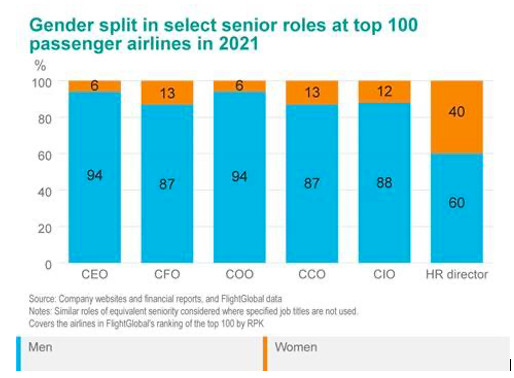The aviation, aerospace, and defense industries, while traditionally male-dominated, are experiencing a significant shift as women increasingly ascend to executive positions. This progress is a testament to decades of dedication and talent, yet it also highlights a crucial ongoing mission: to fully recognize and celebrate the historical and contemporary roles women play in these vital sectors. From the earliest days of flight to the cutting edge of space exploration, women have been instrumental, often behind the scenes.
 Women in Aviation Leadership
Women in Aviation Leadership
While the advancement of women to leadership roles is a cause for celebration, recent studies reveal that true gender parity remains a distant goal. The narrative of women in aviation often overlooks their historical contributions and the systemic biases that continue to shape their careers. To achieve genuine equity, it’s essential to understand the historical context, acknowledge current challenges, and actively champion the changes needed for women and other underrepresented groups to achieve their rightful place in aviation, aerospace, and defense leadership.
The Stark Reality: Studies Highlight the Need for Systemic Change
Several recent studies underscore the slow pace of progress and the persistent systemic barriers hindering women’s advancement in aviation leadership.
McKinsey & LeanIn.Org Study: C-Suite Gains vs. Operational Roles
A comprehensive study by McKinsey & Company and LeanIn.Org reveals a mixed picture. While there’s been commendable progress at the very top, with women’s representation in the C-suite rising significantly, these gains are not translating into operational roles that are crucial stepping stones to CEO positions. The Wall Street Journal’s coverage of the study highlighted this critical point: women are often elevated to staff roles, such as Chief HR Officers, rather than line management positions with profit and loss responsibilities. These operational roles, historically the pathway to the chief executive office, remain predominantly filled by men.
 McKinsey & LeanIn.Org Study
McKinsey & LeanIn.Org Study
The study further indicates that the career progression gap between women and men emerges early. At the first promotion to manager level, women are already falling behind, with approximately eight women promoted for every ten men – a ratio that has stagnated since 2018. This early disparity compounds over time, limiting the pipeline of women ready for senior operational and executive roles.
World Economic Forum: Centuries to Gender Equality?
The World Economic Forum’s sobering report on the gender gap suggests that achieving true gender equality may take centuries at the current pace. The report proposes a strategic shift towards focusing on income equality rather than just wage equality, highlighting the deep-seated systemic issues that contribute to gender disparity.
Korn Ferry and IAWA: Female CEOs in Aerospace & Defense – A Closer Look
While the aerospace and defense sector shows a higher percentage of female CEOs compared to the overall industry average (19% vs. 5% in the US), a study by Korn Ferry and the International Aviation Women’s Association (IAWA) reveals a more nuanced picture. Although aerospace and defense are ahead of other sectors, only a mere 3% of airlines are led by women CEOs. Alarmingly, the report points to a thin leadership pipeline, suggesting that future progress may be slow without focused intervention.
MIT Sloan Management: Fortune 500 Milestone, Yet Still a Small Number
In a landmark moment, MIT Management reported that women now lead 10% of Fortune 500 companies, the highest percentage in history. While this is a milestone worth celebrating, it still represents a small fraction of leadership positions in the largest US corporations.
IATA: 25by2025 Initiative – Progress and Challenges
The International Air Transport Association (IATA) set a goal in 2019 to have women hold 25% of airline senior leadership positions by 2025 under its 25by2025 initiative. While progress is being made, with participating airlines reporting an increase in women in senior leadership roles from 24% in 2021 to 28%, IATA acknowledges that the industry is not on track to meet its target. A significant hurdle is the insufficient number of airline members pledging to improve gender diversity at the executive level. However, the appointment of Yvonne Makolo, CEO of RwandAir, as IATA’s first female chair is a significant step forward.
EU Legislation: Addressing Boardroom Imbalance
The European Union is taking legislative action to address gender imbalance in corporate leadership. New EU rules mandate that publicly-listed companies must fill at least 40% of non-executive director posts or one-third of all director posts with women by July 2026. The legislation also includes penalties for non-compliant companies, signaling a strong commitment to gender diversity at the highest levels of business.
LinkedIn and World Economic Forum: Recent Setback in Progress
A LinkedIn study featured in the World Economic Forum’s 2023 Global Gender Gap Report revealed a concerning trend. After years of slow but steady progress in women’s leadership (approximately 1% annual increase), the first quarter of 2023 saw a drop in the percentage of women in senior leadership to 32%, reverting to pandemic-era levels. This setback underscores the fragility of progress and the need for sustained efforts to promote women in leadership. Globally, women hold nearly half of entry-level positions but only a quarter of C-suite roles, with STEM fields exhibiting even greater disparity, where women occupy a mere 12% of C-suite positions.
University of Phoenix White Paper: African American Women – Unique Challenges
A white paper from the University of Phoenix College of Doctoral Studies highlights the unique challenges faced by African American women in the workplace. These women are disproportionately underrepresented in senior leadership roles, facing higher levels of bias. While women overall hold one in four C-suite positions, only one in 20 are women of color. The paper emphasizes the need to foster a sense of belonging and address the specific barriers preventing African American women from advancing into leadership.
Aviation International News: Engineering Skills Gap and Women’s Potential
Aviation International News reported that women are gradually increasing their presence in engineering roles, reaching 20% in some companies like Raytheon Technologies. Boeing and BAE Systems also show incremental increases in women engineers in their workforce and apprenticeship programs. However, the report stresses that women remain underrepresented in engineering positions compared to the overall workforce gender ratio, particularly when the aviation industry faces a growing skills gap in engineering. Actively recruiting and supporting women in engineering is crucial to address this gap and foster innovation.
Women in Aviation: Making a Tangible Difference
Research increasingly demonstrates that having women in leadership positions is not just about equity; it’s also beneficial for business performance and organizational dynamics.
Harvard Business Review: Diversity in the C-Suite Drives Change
A Harvard Business Review article explores the positive impact of women in the C-suite. The research suggests that companies with women in top leadership roles become more open to change and less risk-averse. These organizations are more likely to embrace transformation while carefully managing associated risks. Furthermore, firms with female executives shift towards knowledge-building strategies focused on internal R&D, as opposed to solely relying on mergers and acquisitions for knowledge acquisition. The more effectively female executives are integrated into leadership teams, the greater their positive influence on decision-making and organizational culture.
CNBC: Advice from Fortune 500 Female CEOs
CNBC reported on the record number of female CEOs in the Fortune 500 in 2022. Despite this progress, women still lead less than 10% of the largest US corporations and hold only 21% of C-suite positions. The CNBC report highlights valuable career advice from these pioneering female CEOs, offering insights for aspiring women leaders in aviation and beyond.
Flightglobal Survey: Progress Undermined by C-Suite Representation
Flightglobal’s 2023 survey found that while the number of women leading airlines has doubled, progress in overall female representation in the C-suite is undermined by declines in other key executive roles. When considering five additional C-suite roles beyond CEO, women accounted for only 15% of incumbents, a figure stagnant compared to the previous year. Excluding HR director roles, the representation drops to a mere 10%, also unchanged from the previous year, indicating a lack of meaningful progress beyond the CEO level. However, the survey did note JetBlue Airways as the only carrier with a majority of women in surveyed C-suite roles, with North America leading globally in female representation.
Celebrating Women in Aviation Leadership: A Call to Action
While the data reveals persistent challenges, it’s crucial to recognize and celebrate the women who are breaking barriers and leading the way in aviation, aerospace, and defense. FA/AW News has compiled a comprehensive list of women executives in these sectors to highlight their achievements and inspire future generations.
 Rosie the Riveter Inspiration
Rosie the Riveter Inspiration
This list serves several key purposes:
-
Recognition and Celebration: To honor the women who have shattered the glass ceiling and reached leadership positions in airlines, aerospace and defense companies, government agencies, associations, airports, museums, and business aviation.
-
Illustrating Diverse Career Paths: To demonstrate the vast range of opportunities for women in aviation and aerospace, regardless of their specific passion or skill set – from interior design and finance to engineering and piloting.
-
Highlighting Entrepreneurial Spirit: To showcase the women who have carved out unique spaces in aviation and aerospace through their innovation and entrepreneurial drive.
-
Honoring Historical Contributions: To remind us that women have always been a part of aviation and aerospace, even when their contributions have been overlooked or minimized.
FA/AW News encourages readers to contribute to and update this list, particularly in identifying the first women to fly commercial jets for airlines, ensuring a more complete and accurate record of women’s leadership in aviation.
Additional Resources:
- Inspirational Women Who Flew Before the Wright Bros.
- Women in Aviation: Past, Present and Future
- Teaching Women to Fly
- Trailblazing Women of Air & Space by Dr. Penny Hamilton
- Aviation Women Inspiring the Next Generation
For additions or corrections Contact: [email protected]
© April 4, 2023, Future Aviation/Aerospace Workforce News
(The extensive list of women executives in Aerospace & Defense, Civil Aviation/Aerospace, Associations, Business/General Aviation, Advanced Air Mobility, Airports/State Aviation Officials, Aviation/Aerospace Educators, Aviation Museums, Unions, and “On Their Shoulders…” from the original article should be included here, maintaining the original formatting and images with updated alt text as per instructions.)
Share this:
Like Loading…

